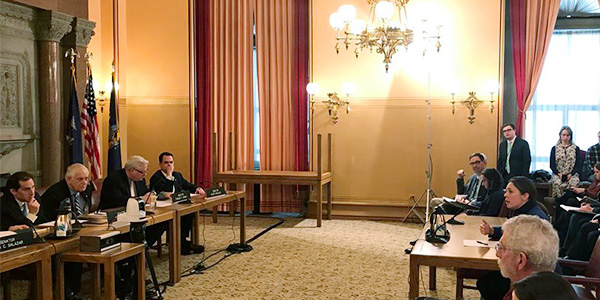By Michael Kuser
Nearly 40 people braved a snowstorm Tuesday to testify on a bill that aims to put some of New York’s ambitious decarbonization goals into the statute books.
The testimony over the draft Climate and Community Protection Act (S7971A) was part of the New York State Senate’s first-ever hearing on climate change, held by the Committee on Environmental Conservation and chaired by Sen. Todd Kaminsky (D). Control of the Senate this year passed to Democrats from Republicans who had declined to take up the issue.
Last month, Gov. Andrew M. Cuomo vaulted the state ahead of all others in renewable energy targets by pledging to erase the state’s carbon footprint by 2040 and nearly quadrupling its offshore wind energy goal to 9 GW by 2035. (See New York Boosts Zero-carbon, Renewable Goals.)
“Here in New York, public policy is informed by science, and we are collectively committed to taking action to address the climate crisis,” Alicia Barton, CEO of the New York State Energy Research and Development Authority, said at the hearing. “The discussion today is not about whether to act, but how best to act.”
The proposed bill specifically targets sectors other than the electric generation sector, Kaminsky pointed out. He asked Barton whether lawmakers should place emission caps on transportation and buildings, for example.
“Our efforts are much more mature in the electric sector,” Barton said, adding that similar work and analysis would be needed in other sectors, including “pushing the markets to advance more quickly… in building decarbonization and electrification and emissions reduction in the transportation sector.”
70% Renewable by 2030
The cornerstone of the new state goal: to increase of the state’s Clean Energy Standard mandate from 50% to 70% renewable electricity by 2030.
The governor’s proposal “sets the 100% clean electricity standard by 2040 but also directs the Climate Action Council to develop a roadmap to a carbon-neutral economy,” Barton said.
Last fall’s report by the U.N.’s Intergovernmental Panel on Climate Change “stated that there is no historic precedent for the magnitude of changes that are necessary,” Barton said. “The good news is that we have been making progress faster than we thought just a few years ago … technology has been breaking our way and costs have been breaking our way.” (See IPCC: Urgent Action Needed to Avoid Climate Trigger.)
She said nobody foresaw the incredible cost declines in technologies such as offshore wind even a few years ago, “and I think we have every reason to hope that we will see those same transformations take place in transportation and in the building sector.”
Sen. Brian P. Kavanagh (D) asked Barton whether the administration would think it “imprudent to try to develop legislation” while the state agencies are working out their plans to achieve the state’s energy goals.
Barton declined to speak for the governor but said “given where we are today, doubling down and accelerating quickly in the electric sector is something that we believe is technologically reasonable” and cost-effective.
She added that New York also has “the most aggressive energy storage targets in the country” and that many projects should start to come online in the second half of the year.
Sen. Julia Salazar (D) asked what the state is doing to protect people of color and low-income residents, who tend to be impacted most by higher electricity rates. Barton said NYSERDA is working on a number of programs “across the board to make sure that low-income New Yorkers have access to solar energy and other new renewable energy resources.”
Bill sponsor Sen. Brad Hoylman said the draft legislation “aims to build up those communities through direct targets in terms of prevailing wage, apprenticeship utilization and the like.”
“Does the governor’s plan have those kinds of good job-making targets?” he asked Barton.
“Already today NYSERDA has taken the step of requiring prevailing wage under our large-scale renewable energy solicitations,” Barton said. “The state’s request for proposals for offshore wind energy was the first in the country to require a negotiation of project labor agreements, and the agency has allocated $70 million for workforce training.” (See New York Plans for Wind Energy, Related Jobs.)
No Rolling Blackouts

Peter Iwanowicz, director of the Environmental Advocates of New York, advised legislators not to be swayed by naysayers.
Iwanowicz recounted how New York’s power companies provided three warnings before the state joined in creating the Regional Greenhouse Gas Initiative: “First, RGGI was going to drive prices through the roof. Second, there’d be blackouts in New York City. Third, and this is really unbelievable, but I was told this directly, power companies were going to shut down in New York and move to Pennsylvania just to avoid RGGI.”
Darren Suarez of the Business Council of New York State said that its members oppose the legislation and that if measures taken “in New York result in increased emissions elsewhere in the world, we’ve done nothing to solve the problem.”
“The European experience demonstrates that well-intentioned environmental policies can result in higher energy production costs, driving carbon leakage and output leakage,” Suarez said. “To those who say the legislation is aspirational … this is not a goal, it’s a law, and the law will require that emissions be 50% below 1990 levels by next year.”
“The pace at which we should make these changes has been hotly debated,” said Roger Downs of the Sierra Club. “In some ways it is not unlike evacuating people from a burning theater. Moving too fast in a panic has the same dire consequences as moving too slowly.”
The committee heard from foresters, forest product makers, bird lovers, and also from a Californian who supports running heavy industrial vehicles on renewable gas.
Sam Wade of the Coalition for Renewable Natural Gas, who ran California’s low-carbon fuel standard program for the past 10 years, testified that “taking one big diesel rig off I-87 today is the carbon emissions equivalent of taking 119 gasoline-powered cars off the road.”











